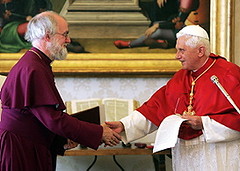 Image by ManilaRyce via Flickr
Image by ManilaRyce via Flickr
On Friday evening, 17 September 2010, I attended the service of evening prayer at Westminster Abbey, led by Pope Benedict XVI and the Archbishop of Canterbury. It seems this was an historic event. This was the first time any Pope has set foot in Westminster Abbey and I think the first time a Pope has led a service with any Archbishop.
So, what do I make of all this? How will this service be viewed in 10 or 20 years time? I suspect it will be mentioned in the guide books at the Abbey; will it have any more significance than that?
One problem I had was, being somewhat hard of hearing, I had difficulty hearing what the Pope was saying. I hope to track down and read his speeches and so will comment on them later. I was sat in Poet's Corner, not far from William Blake, and there was a screen between us and the high altar, where the service took place. So, my comments this time are upon the event itself.
As a non-conformist, I find this type of ceremony less moving than many people seem to and so much of the emotion passed me by. But I think it was significant they were able to make this commitment together. The point at which they prayed together at the tomb of St Edward the Confessor moved many people. For me perhaps the most moving moment was right at the end of the service when the two men walked down the chancel steps. I noticed the Archbishop was supporting Benedict. Perhaps this is a sign of personal warmth between them, I hope it is.
This was an act that primarily took place between two traditions, Roman Catholic and Anglican. Leaders from other churches were present as witnesses but this was certainly not a multilateral ecumenical event. This is not necessarily a bad thing and is certainly understandable in view of the venue.
My deepest concern is more difficult to express. I've sat in on planning several liturgies where delicate issues have had to be addressed. I've seen the way in which positive gestures can be used to skirt around other difficult and deeper issues. My impression was Benedict was there to pray at Edward's tomb.
It did not feel as though the divisions between the two churches were being addressed. I wasn't expecting any grand gestures but the reality of the blood shed between these churches a few centuries ago was an unspoken presence. Was Benedict there to pray at the tomb or to heal the divisions?
Some would say both. Maybe that's true. But if both, why did we need the prayers at the tomb? Yes, I accept this was a significant step on the way (how significant we will learn in time) but it seemed to me the Pope was still holding this relationship at arm's length.
I feel uneasy about it. This was not ultimately the normally easy relationship Protestants and Catholics experience in England. It certainly isn't enmity. But is it friendship?









Recent Comments